Clouded agaric – identification, distribution, edibility
Clouded agaric, clouded funnel – Clitocybe nebularis (I have also seen it listed as Lepista nebularis)
- Edibility 2/5 – While some people eat and enjoy this mushroom (well cooked), it can cause gastric upsets in some people. Please read the linked articles and comments below.
- Identification 3/5 – See below. Possible confusion with livid pinkgill (entoloma sinuatum) which is highly poisonous
- Distribution 4/5 – common and highly gregarious, often forming huge rings
- Season October-December
- Habitat: Under almost any tree type, growing on fallen leaf/needle litter or rich soil. I have also found it growing in grass well removed from the nearest tree.
Key features: Cap pale to ash grey, fleshy, dry, inrolled at the margin on young specimens which tend to be dome shaped. Older caps flat and broad up to 15cm. Gills white to cream, decurrent (descending down the stem), easily detatchable, spores white-cream. Stipe solid, broader at the base. The general jizz (as bird watchers call it) of this mushroom is grey, solid, robust, and gregarious – especially in large, well-formed rings.
This is one of those awkward mushrooms that doesn’t agree with everyone. Roger Phillips reports that it is “Said to be edible, but known to cause gastric upsets in many people“. As is so often the case with saprophytic fungi, the clouded agaric may have markedly different composition depending on which substrate it is growing on. This may further complicate uncertainties around personal tolerances.
As I discuss in more detail in this post on The Spectrum of Edibility, “edibility” is a much more complicated concept than we tend to appreciate. This paper on clouded agaric lists its potentially beneficial properties (albeit based only on testing on mice), while this paper goes into some detail on its potentially harmful properties. I suggest you read both before deciding whether this is a mushroom you might wish to eat.
I have personally eaten this mushroom on several occasions and enjoyed, after thorough cooking, its sweet yet sharp flavour which works particularly well with fish and pickles well too. Having only recently come across the second paper linked above, I am now more circumspect about eating clouded agaric. If you choose to eat it, i’d now recommend boiling in water then discarding the water before cooking
Discussions of toxicity aside, this also appears to be one of those foods that actually tastes different to different people – some find it rank, despite not getting any adverse symptoms.
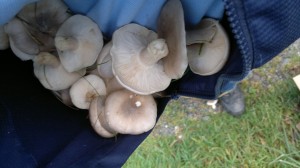
Huge numbers of clouded agaric can be lurking around any tree or bend in the road. Bagless, I had to improvise with this lot and stuff them into my jacket.
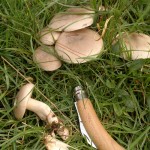
Don’t be too scared of the superficially similar but much rarer livid pinkgill which has pink spores, ascending gills and a floury odour.
If you do choose to eat clouded agaric, please leave a comment below to let me know how you got on with it.
- Edible wild plant guide
- Wild foods in season now
- Edible wild fungi guide
- Wild food recipes
- The Day I Ate A Deadly Plant: The Spectrum of Edibility
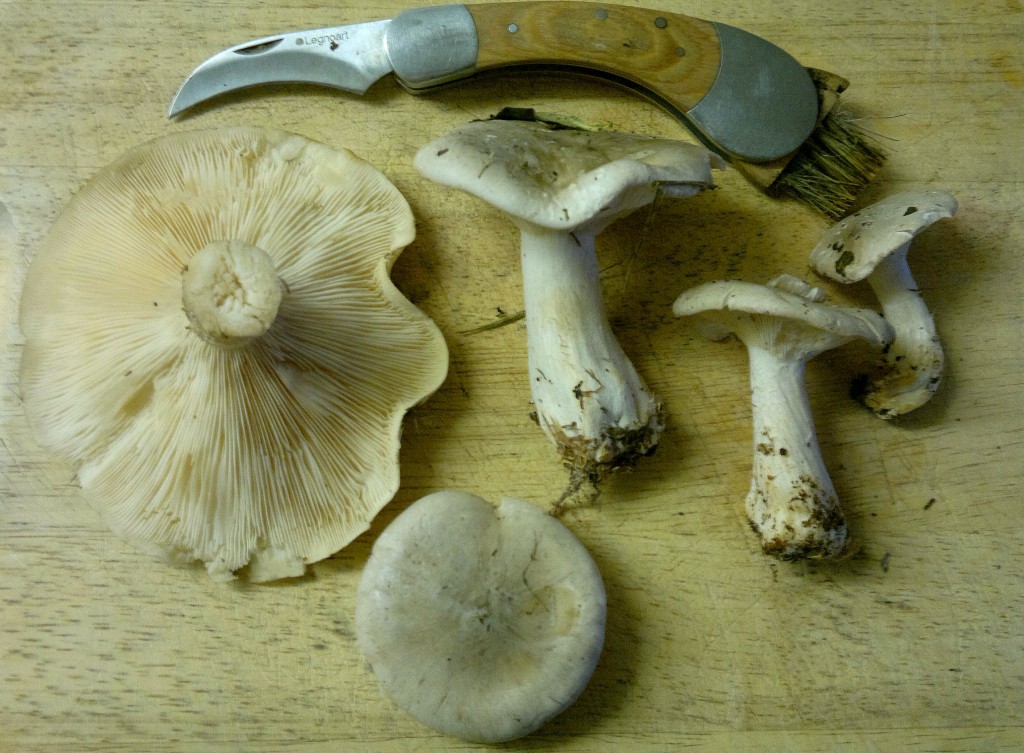
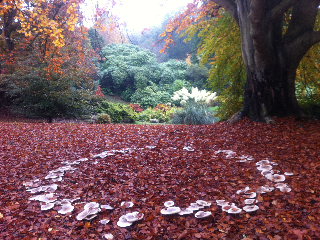
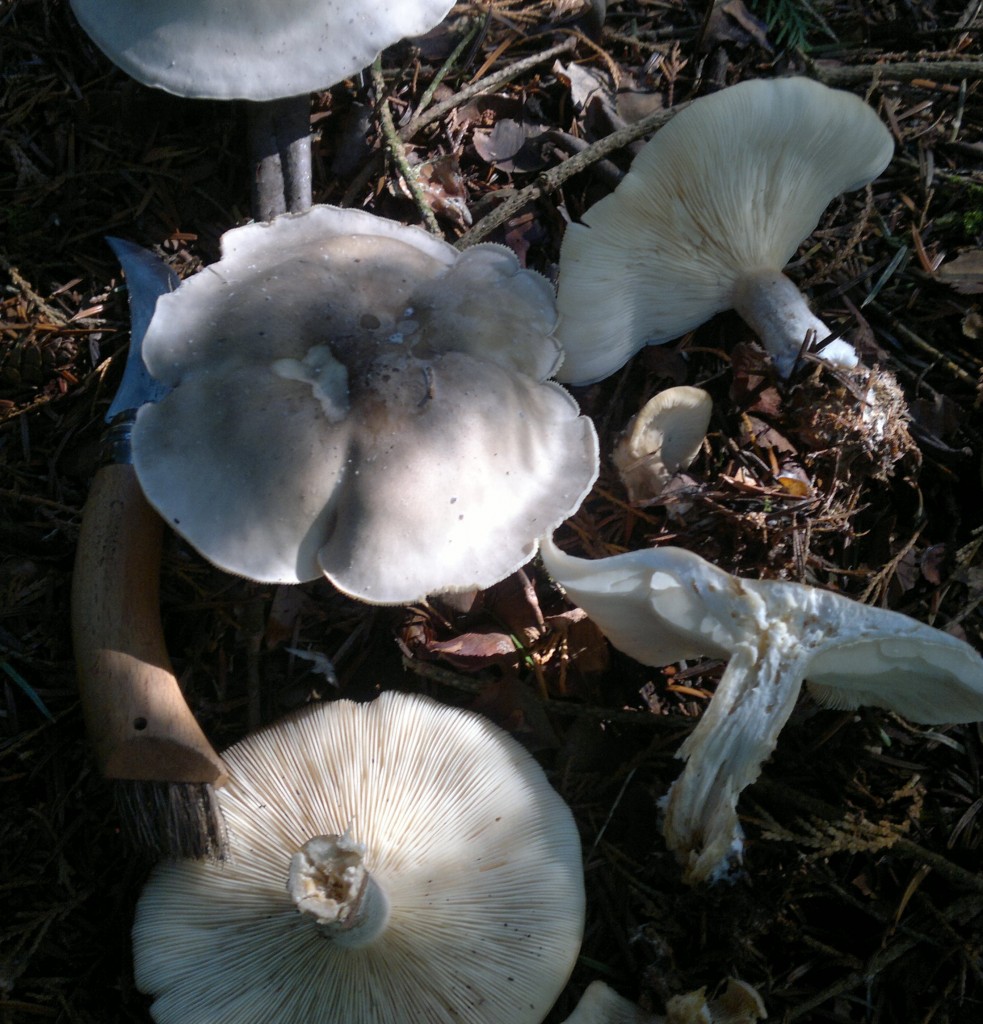
30 Comments
Hello. I live in France and we found these mushrooms at the weekend. We were accompanied (fortunately) by a knowledgeable friend who identified them as clouded agaric. We tasted a small amount, simply fried in butter, and they were delicious. Quite a strong flavour that is often described as ‘fungal’ over here. They smell nice too when they’re raw but I can’t describe any of the complexities of the aroma as I don’t have the mushroom vocabulary!
Hi Oliver, Glad you enjoyed them! Really abundant over here yet so many people ignore them.
There are a lot of these mushroom in the nearby nature reserve along with a lot of other species. I always a bit concern if I am the group of the people that may be affected by it. I braved myself today to cook and eat some today and find them quite delicious. And I have to say that my tummy seems to agree with them so far.
Ya learn somtheing new everyday. It’s true I guess!
I noticed these huge mushrooms next to our driveway last year, but didn’t research them. This year, I researched the heck out of them, and am confident this is the mushroom. I tried a few small bites cooked in butter last night. They were delicious. No ill effects. You mentioned pickling them. I think I will try that. There are so many and they are so meaty, I am delighted that I can eat them! Thank you for this very informative blog. If you have pickling hints, I would appreciate them.
Great stuff Robin, glad you enjoyed them. I saute, rinse in hot water (to remove oil/butter) and jar in vinegar with spices infused to taste. I’m sure you will access better directions online, but the best thing is to play about a bit and see what works for you!
Inspired by this website I finally bit the bullet today. Subtle and gorgeous. I’m definitely a convert. Three hours later and no gastroirritant problems. We’re all good. These guys are in Perthshire mixed woodland. No really discernible rings. More kind of groups. There are Wood Blewits nearby, I’m delighted to report. The Parasols are still hiding.
Hi all,
Given the welcome, but peculiar, shift in our weather, one of our best foraging tools namely the season, has become less reliable. I am sure we all can think of unseasonal examples, I myself am collecting bitter cress for the fourth times this year, in mid December! So without wanting to cast a cloud over enthusiasm for fungi, please be aware that there are several very poisonous mushrooms of this general shape and colour. Some of these undesirables may well produce fruiting bodies outside their expected `season`. I don’t eat any white or cream coloured mushroom other than puffballs, inkcaps and hedgehog’s which have unmistakable features.
I should add that I generally advise spore printing to confirm identification, but often ignore the advise myself!!
Happy hunting, Steve
Hi Steve,
Not sure where you are – interesting to hear about weather shifts. In W Scotland we generally experience “autumn” for at least 6 months of the year … wet and mild. I notice cyclical variations among many species, not always obviously related to weather patterns.
Bitter cress is an all-year round crop hereabouts and i’m lucky enough to have a great patch of cardamine raphanifolia that tastes great 10 months of the year.
I’m glad to hear you only harvest within your identification “comfort zone” – of course nobody should eat anything that they are not 100% sure of. This is no reason not to explore new species though. Harvesting wild food becomes less sustainable when people restrict themselves to only a few well known varieties. And as noted in the post – they will be missing out on some potentially delicious stuff.
I don’t get your point about seasonal climatic variation affecting safety. Anyone harvesting wild mushrooms should be positively identifying everything they plan to eat at any time of year – with extra care if they don’t seem “seasonally appropriate”.
I use spore printing to aid identification, seldom to confirm it, but it is certainly a good starting point for narrowing down to genus.
Happy hunting,
Mark.
Well I am so happy I came across this page of yours Mark, I was in the woods with my son today making a little clearing to camp in future, I normally find Porcini & the occasional peppery boletes if I am lucky, but along with my usual 2 I discovered these & brought a couple of specimens home to I.D & after looking through all 4 of my mushroom books I had already decided after correctly identifying them to actually discard them, as the books all said to avoid due to possible gastric problems, but my hunch of them being a possible candidate for the table had me search online further, as I do as already said eat the peppery boletes which most books say the same about & they are a great eating mushroom IMO, so after reading your page & the comments, I fried a few slithers up with some butter & a little salt, boy am I glad I did, the flavour & texture are excellent & one I am very happy to add to my list of edibles, thank you so much for taking your time to write this little page on them Mark, most appreciated, thankfully I have a pretty much cast iron constitution, so with luck I will not have any gastric issues with them, but I will report back if I do have any issues. delighted to find something else edible here as I am in what is regarded as one of the worst places for foraging in the UK Just one small question – you say above to avoid the smaller specimens – may I ask why??
Hi Frank,
Great stuff, so glad you have a new item in your wild larder.
Information like that you have shared here is really useful for building up an “edibility profile” of lesser-eaten species. Most guide books tend to regurgitate (no pun intended!) the information in earlier books, which may well be based on some very subjective evidence back in the mists of time. Up-to-date reports from mindful foragers who know what they are doing are invaluable.
I have to be honest, i’m not sure why I wrote “avoid young specimens”… I’m guessing this is based on them possibly being harder to identify and digest at that stage, but i’m not sure I have any evidence for this! Hmmm… must be getting old!
You may also like this blog on “The Spectrum of Edibility”: http://www.gallowaywildfoods.com/?page_id=1675
Cheers
Mark
I am cooking them right now!)
Hi Mark I was come across this Clouded Agaric this month Nov, and post question to your facebook to confirm that I might mistake with a similarly to the other. But at the end I have to search it myself and also try a little for start. As two days gone by surviving from gastric problems.lol now I am confident to cook them regularly.
So sorry I did not get a reply back up sooner, was it the throws of moving home, but after finding some more today which you kindly confirmed on facebook via PM it made me remember I should have come back to check on hear a long time back, the ones I found today were in a totally different environment, much smaller & of a much different colour to what I have previously found, more brown & smaller compared to what I have normally associated being a clouded agaric, they were right on a bluff between two hill’s overlooking a sheer cliff drop right on the coast, I actually almost walked straight by them, but something stopped me & I took a few home to try to ID, just cooked some up & remembered what I have been missing as found not a one last year.
I have to say if you have never tried these, then you are missing out on a real hidden treasure, now if only those dam Cep’s would also show up, though already getting late for them.
Greetings from the Czech Republic! This is one of my favourite species of mushroom, especially since it tend to be abundant even when there is not much else some years. The general recommendation in this country as far as Clitocybe nebularis is concerned is if you find its highly distinctive smell pleasant, you can probably eat them safely. If they smell offensive to you, you are better off not eating them, as some people are allergic to them. I personally love them, and they agree with me. Some family members find the smell unpleasant and they reported mild stomach trouble after eating them, so I guess it works. I brought a big basket of them yesterday, and tried pickling the young ones in vinegar for the first time – really delicious, with very pleasant texture.
Hello from Estonia, a few quick words of apreciation for your site. Together with Wood blewits this is the most frequent species in the woods right now, have tried them repeatedly and can confirm what other posters say, they are really delicious and no adverse effects. Will have them agan tonight, found a good patch of fresh growth in a small gully that cuts accross the neighborng patch of forest.
Picked four yesterday and ate for lunch, they are delicious, cooked in butter a shake of Maggi, well the Polish version of Maggi. As most Brits are wary of any wild fungi, I will probably enjoy all to myself, although when I do cook any of my foraged fungi and a male friend is around, they cannot resist trying, even one with ibs. The area I live is Hampshire/Berkshire borders
this is the first time I picked up the courage to do so, after Roger Phillips warning. What a super discovery, thanks another edible one, no problem with digesting. So far this year, chanterelles, horn of plenty and amethyst deceiver, boletus poor and scarce not worth gathering, which is a worry. I am a Brit, get fed up of I prefer to buy mine from Sainsbury’s
I’ve been ‘eyeing up’ a small troop of Clouded Agarics for two days and I fried a couple in butter today: delicious! Much tastier than the Grisettes that accompanied them on my plate.
There are lots coming up on the Sussex Downs where I live so I’ll be making the most of them in November.
No gastric issues at all with me, Rory
We found a big bunch of these specimens in Wimbledon in London. At first I thought it was a type of blewit. But couldn’t identify. We took a spore print and also I was 95% sure it wasn’t anything deadly, so decided to fry up a small sample. With no upset, we ended up frying up the lot with butter garlic and rosemary and they were up there with some of the nicest tasting mushrooms I’ve had. My partner and I didn’t get ill, so it’s a double thumbs up as I tend to find these often.
I think a small test eating is a sensible idea!
Great post. Thanks
Ben
I picked a few of these this afternoon, and ate one a few hours ago, having decided to take the cautious approach. I feel fine, no discomfort, and it was a delicious mushroom, so planning on eating a few more tomorrow. Thanks for this page, the links are informative, as are other peoples’ experience of eating them.
These are a really tasty mushroom to eat, but I would recommend picking the more mature fruit bodies, because they are less likely to cause any gastric problems
Hi, two of us ate a panful of these last night, no upsets. I’d describe the taste as like eating a plate of horse mushrooms next to a person wearing floral perfume. 😀
Tried small amount to begin with, roasted in groundnut oil and butter, absolutely delicious mushrooms flavour, love it but still wary, any thoughts on dried?
I haven’t tried drying them, but there is no reason I can see not to try it.
Hi!
Picking and eating these muchrooms since my childhood. They are very tasty, easy to identify and there are plenty in the season. Never met anyone with an actual gastric upset because of this mushroom. They are also drying well as far as I remember, but haven’t dried them lately.
Similar to other commentors here, we thought at first these looked like blewits, minus the colour.
Anyway, we were thinking we’d best not eat them after reading the whole ‘1-in-5 people report alarming gastric issues’ thing. But smelling them convinced us to at least try washing, and frying one in butter. They smell so good. And can now confirm, they taste good too. Somewhere between wild-mushroomey, meatey, nutty and cheesey when fried in salted butter.
Now we wait.
And? I’m going to do the same here! They look too inviting not to try! And I typically have a strong stomach… Fingers crossed.
Hi,
I ate these for the first time – more in number than I could shake a stick at, here in Norfolk, near Aylsham.
Cooked them in stews and in omlettes and found no side effects at all..quite tasty.
I have also eaten, over the last three years, Paxillus involatus, as they were pounced upon by my Russian wife while out walking, as being good to eat, again both of us expreiencing no side effects; maybe I have a cast-iron stomach!
However, having since read more about them, and the damage which long-term ingestion might do, I’ve decided to give them a miss; shame as there are loads appearing this year – so far the best year for all mushrooms, that I’ve ever seen! Even picked a 820 gm Boletus edulis (one of three)!
Good stuff. You are right to be extremely cautious eating brown rollrims (p.involutus) – people have from died eating them, including eminent mycologist Julius Schaffer!
not being knowledgeable found several pounds of cloudy clitocybe growing on a pile of shredded tree trimmings your comments have encouraged me to give em a try. have not seen them before here in north east Ohio hopefully they’ll be back next